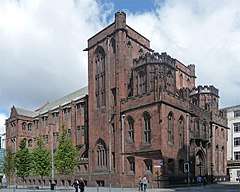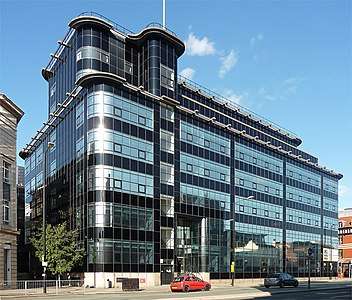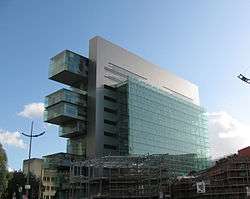Manchester Cenotaph
| The Cenotaph | |
|---|---|
| United Kingdom | |
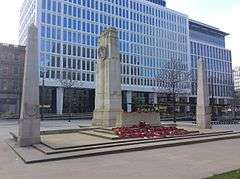 Manchester Cenotaph in 2017, in its new location by the town hall | |
| For casualties of the First World War (modified to include the Second World War and later conflicts) | |
| Unveiled | 12 July 1924 |
| Location |
53°28′43″N 2°14′34″W / 53.4787°N 2.2429°WCoordinates: 53°28′43″N 2°14′34″W / 53.4787°N 2.2429°W St Peter's Square, Manchester, England |
| Designed by | Edwin Lutyens |
Listed Building – Grade II* | |
| Official name | Manchester War Memorial |
| Designated | 3 September 1974 |
| Reference no. | 1270697 |
Manchester Cenotaph is a First World War memorial, with additions for later conflicts, designed by Sir Edwin Lutyens for St Peter's Square in Manchester, England. Manchester was late in commissioning a war memorial compared to most British towns and cities—the city council did not convene a war memorial committee until 1922. The committee quickly raised £10,000 but finding a suitable location for the monument proved controversial. The preferred site in Albert Square required the removal and relocation of several statues, and was opposed by the city's artistic community. The next choice was Piccadilly Gardens, an area ripe for development, but in the interests of expediency, the council chose St Peter's Square, although it already contained a stone cross commemorating the former St Peter's Church. Negotiations to move the cross were unsuccessful and the cenotaph was built with the cross in situ.
The choice of architect was initially to be decided by open competition, but the committee was criticised in the local press when it reserved the right to overrule the result. It abandoned the competition and approached Lutyens, who produced a variation of his design for his cenotaph in London. The memorial consists of a central cenotaph and a Stone of Remembrance flanked by twin obelisks, all features characteristic of Lutyens' works. The cenotaph is topped by an effigy of a fallen soldier and decorated with relief carvings of the imperial crown, Manchester's coat of arms and inscriptions commemorating the dead. The structures, based on classical architecture, use abstract, ecumenical shapes rather than overt religious symbolism. The memorial was unveiled on 12 July 1924 by the Earl of Derby, assisted by Mrs Bingle, a local resident whose three sons had died in the war. It cost £6,940 and the remaining funds were used to provide hospital beds.
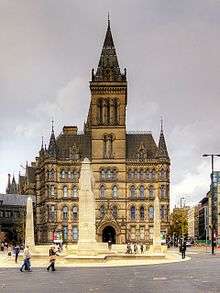
In 2014, Manchester City Council dismantled the memorial and reconstructed it at the northwest corner of St Peter's Square next to Manchester Town Hall to make room for the expanded Metrolink tram network. It is a grade II* listed structure and in 2015, Historic England recognised Manchester Cenotaph as part of a national collection of Lutyens' war memorials.
Background
In the aftermath of the First World War and its unprecedented casualties, thousands of war memorials were built across Britain. Virtually every town or city erected some form of memorial to commemorate their dead. During the war, only London provided more recruits to the British Army than Manchester. The Manchester Regiment and the Lancashire Fusiliers, which largely recruited from the city and towns to the north, were swollen by pals battalions drawn from local employers, social groups, and neighbourhoods.[1] By the end of the war, over 13,000 men of the Manchester Regiment, including more than 4,000 from the pals battalions and 13,600 Lancashire Fusiliers, had been killed. An estimated 22,000 Mancunians died and 55,000 were wounded.[2]
Commissioning
Many towns and cities began to erect war memorials after the armistice, but Manchester did not get underway until 1922. As a result of pressure from the local branch of the Royal British Legion, the city council formed a war memorial committee, chaired by the mayor, to explore options for commemoration.[3] The committee raised £10,000 in subscriptions and donors were told that local firms would benefit from the construction and resulting employment.[4]
Three potential sites were considered for the memorial: Albert Square, Piccadilly Gardens and St Peter's Square. With the support of the Royal British Legion, Albert Square emerged as the favourite. The site proved controversial after the artistic community led the objections to the removal and relocation of statues in the square, which would have been required to create a suitable space for the war memorial. King George V consented to the relocation of the memorial to his German grandfather, Prince Albert, but objections persisted and the city architect estimated the cost of relocating the statues at £8,400. The city council voted to reject Albert Square and identified Piccadilly Gardens as its second choice. The city council was considering building an art gallery on the open space left after the old infirmary was demolished. Siting the memorial in front of it was supported by the Art Gallery Committee.[4] As nothing was decided, any plans for the area would have delayed the war memorial project further and the council settled on St Peter's Square.[5][6][7]

More controversy surrounded the choice of architect. The Manchester Art Federation and other bodies petitioned the city council to hold an open competition, to which the council agreed. The war memorial committee appointed Percy Worthington, a local architect, as the assessor for the competition but attracted severe criticism in the local press when it reserved the right to veto Worthington's choice. After further debate, the competition was abandoned and a subcommittee approached Sir Edwin Lutyens.[8]
Architect
Lutyens, described by Historic England as "the leading English architect of his generation", was amongst the most prominent designers of war memorials in Britain.[9] Before the war, he had established his reputation designing country houses for wealthy patrons but the war had a profound effect on him and from 1917 onwards he dedicated much of his time to memorialising the casualties. The Stone of Remembrance that he designed in 1917 appears in all large Imperial War Graves Commission (IWGC) cemeteries and in several of his civic memorials, including Manchester's.[9] His cenotaph on Whitehall in London became the focus for national Remembrance Sunday commemorations and one of the most influential designs for war memorials in Britain. Manchester's cenotaph, a close replica, is one of seven in England based on it.[9][10]
Lutyens designed the Thiepval Memorial to the Missing of the Somme, the largest British war memorial in the world, for the IWGC in 1928.[11] Around the same time he designed his only other commission in Manchester, the Midland Bank at 100 King Street.[12]
Design
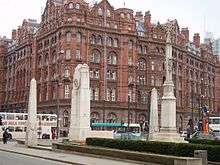
Manchester's war memorial is a cenotaph, flanked by twin obelisks, and a Stone of Remembrance, all in Portland stone on a raised coved platform.[9][13] The memorial covers an area of approximately 93 feet (28 metres) by 53 feet (16 metres).[6] The cenotaph is 42 feet (13 metres) high made from 160 long tons (160,000 kilograms) of Portland stone. The pylon is surmounted by a sculpture of an unknown soldier, partially covered by his greatcoat, lying on a catafalque. The pylon rises from the base in diminishing stages, narrowing as it rises. Below the catafalque, on the front and rear, are moulded swords and imperial crowns, and to the sides are Manchester's coat of arms surrounded by laurel wreaths. The cenotaph bears inscriptions below the coat of arms: "TO THE HONOURED MEMORY OF THOSE WHO GAVE THEIR LIVES FOR THEIR COUNTRY" (on the north-west side) and "O LORD GOD OF OUR FATHERS KEEP THIS/FOREVER IN THE IMAGINATION OF THE THOUGHTS OF THE HEART OF THY PEOPLE" (on the south east).[6][9][14][15] Identical, 23-foot (7-metre) high obelisks stand either side of the cenotaph[16][17] and the Stone of Remembrance is set in front. The stone, a monolith in the shape of an altar, is 12 feet (3.7 metres) long and subtly, aesthetically curved; it is devoid of decoration and inscribed, "THEIR NAME LIVETH FOR EVERMORE".[18][19]
Lutyens' design, with flanking objects, recumbent figure and a Stone of Remembrance set in front of the cenotaph, is reminiscent of his earlier cenotaph in Southampton. While many First World War memorials feature sculpture or overt religious symbolism, Manchester's, like many of his memorials, uses abstract and ecumenical shapes inspired by classical architecture. Its effigy of the unknown soldier raised high on the pylon rather than at eye level is reminiscent of ancient tower tombs. The sculpture's position high above eye level gives the soldier anonymity, complimenting the abstract shapes of the structures and allowing an onlooker to project an image of their own choosing onto it.[20][21][22][23]
The Pevsner City Guide to Manchester described the cenotaph as one of the few impressive war memorials in Manchester but lamented its original cluttered setting and its proximity to overhead wires.[15] The cenotaph, obelisks, and stone are features typical of Lutyens' war memorial work, although Manchester's is one of only two with flanking obelisks—Northampton's has a similar pair of obelisks flanking a Stone of Remembrance.[6][16][24][25]
- Views showing the constituent parts of the memorial
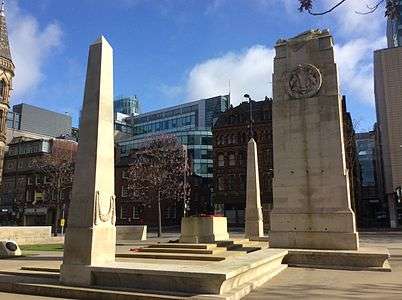 Right obelisk
Right obelisk Cenotaph
Cenotaph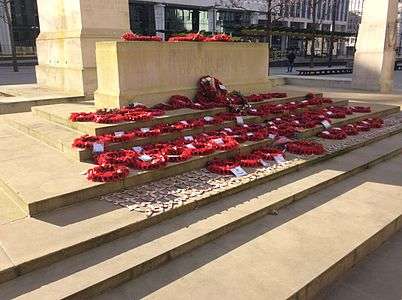 Stone of Remembrance
Stone of Remembrance Left obelisk
Left obelisk
History
St Peter's Square already housed a memorial cross by Temple Moore marking the location of the former St Peter's Church, which was demolished in 1907. The church trustees and the Bishop of Manchester had consented to relocating the cross to accommodate the war memorial, but the trustees reversed their decision by the time building work commenced. Lutyens agreed for the work to continue with the cross in situ.[5][15][26] Negotiations about relocating it recommenced after the unveiling ceremony but the trustees remained reluctant and after further discussion Lutyens said he did not object to it remaining.[4] According to Tim Skelton, author of Lutyens and the Great War (2008), "the heated discussions resulted in a compromise that clearly show[ed]" as Moore's cross "severely impinged on the setting of the memorial and appear[ed] to be an integral part of it".[26]
Despite the war memorial committee's promise that local labour would be used, the monument was built by Nine Elms Stone Masonry Works of London, at a cost of £6,940. It was unveiled on 12 July 1924 by Edward Stanley, 17th Earl of Derby, whose family had been involved in politics for generations, and who held various public offices during the war including Secretary of State for War. He was assisted by Mrs Bingle, a local woman from Rylance Street, Ancoats, who lost three sons in the war. Two years earlier, Lord Derby had unveiled Lutyens' Rochdale Cenotaph, 10 miles (16 km) away.[3][9][27] Mrs Bingle represented "the mothers and wives of Manchester who had made sacrifices greater than life itself". She wore the eight medals awarded to her sons: Sergeant Ernest Bingle aged 34 and Gunner Charles Bingle aged 27 of the Royal Garrison Artillery, and Corporal Nelson Bingle aged 21 of the Royal Engineers. All were killed in 1918—Nelson in March and Ernest and Charles in May.[28]
The unveiling ceremony at Manchester took place in front of a large crowd and a guard of honour from the Manchester Regiment and ex-servicemen. The service was led by the Dean of Manchester, the Very Reverend Gough McCormick, and the Baptist minister Reverend John Edward Roberts of Union Chapel on Oxford Road. Several dignitaries gave speeches including the lord mayor and Lord Derby, who remarked that the memorial was not only a tribute to the dead but a warning as to the cost of war. After the unveiling, a procession of women laid flowers around the base of the memorial.[29][28] The remainder of the £10,000 raised by the war memorial committee was used to provide hospital beds for ex-servicemen and their families.[26] The suitability of St Peter's Square re-emerged in 1925 during discussions about the proposed art gallery and consideration was given to moving the cenotaph to Piccadilly.[4]
A marble plaque, added nearby and dedicated to "OUR ITALIAN COMRADES 1915–1918", was removed during the Second World War but later returned. In 1949 the dates for World War II were added and the surrounding area was laid out as a garden of remembrance designed by the city architect, L. C. Howitt.[15] Another plaque was added later to commemorate the Korean War.[9][27]
In March 2011 Manchester City Council began a public consultation on moving the cenotaph to an alternative site in the square to allow for expansion of the Metrolink tram network. The plans had a mixed reception. Some objections were made by the public but there was support from veterans, church, and heritage groups. The relocation was approved in 2012, and in January 2014 it was dismantled before it was cleaned and restored. In 2014 it was reconstructed in a new memorial garden on the opposite side of the square aligned with Manchester Town Hall's southern entrance. The city council commissioned conservation architects Stephen Levrant Heritage Architecture to manage the relocation and design the new setting which places the cenotaph, obelisks and stone on a plinth in an oval surrounded by a low wall.[30] The garden opened to the public in September 2014. The cenotaph was damaged in the first week when skateboarders began using the area as a skatepark. Repair work costing £4,000 started shortly afterwards, and extra security measures (including 24-hour CCTV) were put in place.[31][32][33][34]
- The cenotaph in the process of being dismantled and moved, 2014
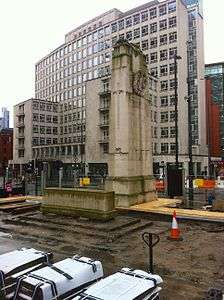
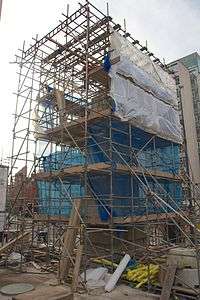

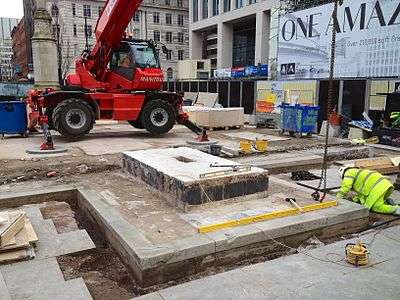
The cenotaph was designated a grade II listed structure on 12 February 1985.[9] Listed status provides legal protection from demolition or modification; grade II is applied to about 92% of listed buildings of "special interest, warranting every effort to preserve them". It was upgraded in 1994 to grade II*, which is reserved for "particularly important buildings of more than special interest" and applies to about 5.5% of listed buildings. In November 2015, as part of commemorations for the centenary of the First World War, Manchester Cenotaph was recognised as part of the "national collection" of Lutyens' war memorials.[35][36]
See also
| Wikimedia Commons has media related to Manchester Cenotaph. |
References
Bibliography
- Amery, Colin; et al. (1981). Lutyens: The Work of the English Architect Sir Edwin Lutyens. London: Arts Council of Great Britain. ISBN 9780728703032.
- Barnes, Richard (2004). The Obelisk: A Monumental Feature in Britain. Kirstead, Norfolk: Frontier Publishing. ISBN 9781872914282.
- Boorman, Derek (1988). At the Going Down of the Sun: British First World War Memorials. York: Sessions of York. ISBN 9781850720416.
- Boorman, Derek (2005). A Century of Remembrance: One Hundred Outstanding British War Memorials. Barnsley: Pen and Sword Books. ISBN 9781844153169.
- Borg, Alan (1991). War Memorials: From Antiquity to the Present. London: Leo Cooper. ISBN 9780850523638.
- Brown, Jane (1996). Lutyens and the Edwardians. London: Viking Press. ISBN 9780670858712.
- Corke, Jim (2005). War Memorials in Britain. Oxford: Shire Publications. ISBN 9780747806264.
- Hartwell, Clare (2002). Manchester. Pevsner City Guides. London: Penguin. ISBN 9780140711318.
- Hartwell, Clare; Hyde, Matthew; Pevsner, Nikolaus (2004). Lancashire: Manchester and the South-East. The Buildings of England. London: Yale University Press. ISBN 9780300105834.
- King, Alex (1998). Memorials of the Great War In Britain: The Symbolism and Politics of Remembrance. Oxford: Berg Publishers. ISBN 9781859739884.
- O'Neill, Joseph (2014). Manchester in the Great War. Barnsley: Pen and Sword Books. ISBN 9781783376124.
- Ridley, Jane (2003). Edwin Lutyens: His Life, His Wife, His Work (Pimlico ed.). London: Pimlico. ISBN 9780712668224.
- Simpson, Andrew (2017). Manchester: Remembering 1914–18. Stroud, Gloucestershire: The History Press. ISBN 9780750978965.
- Skelton, Tim; Gliddon, Gerald (2008). Lutyens and the Great War. London: Frances Lincoln Publishers. ISBN 9780711228788.
- Winter, Jay (2014). Sites of Memory, Sites of Mourning: The Great War in European Cultural History (Canto Classics ed.). Cambridge: Cambridge University Press. ISBN 9781107661653.
- Wyke, Terry; Cocks, Harry (2004). Public Sculpture of Greater Manchester. Liverpool: Liverpool University Press. ISBN 9780853235675.
Citations
- ↑ O'Neil, pp. 17–18.
- ↑ O'Neil, pp. 90–91.
- 1 2 Skelton, p. 63.
- 1 2 3 4 "Cenotaph". National Recording Project. Public Monuments and Sculpture Association. Archived from the original on 19 March 2017. Retrieved 18 March 2017.
- 1 2 Hartwell (2004), p. 332.
- 1 2 3 4 Boorman (2005), pp. 112–113.
- ↑ Skelton, pp. 63–64.
- ↑ Skelton, pp. 64–65.
- 1 2 3 4 5 6 7 8 Historic England. "Manchester War Memorial (1270697)". National Heritage List for England. Retrieved 23 October 2016.
- ↑ Borg, pp. 74–75.
- ↑ "Thiepval Memorial". Commonwealth War Graves Commission. Retrieved 29 March 2016.
- ↑ Historic England. "Midland Bank (1219241)". National Heritage List for England. Retrieved 29 March 2017.
- ↑ Corke, p. 55.
- ↑ Wyke, pp. 130–132
- 1 2 3 4 Hartwell (2002), p. 202.
- 1 2 Barnes, p. 118.
- ↑ Boorman (1988), pp. 123–124.
- ↑ Ridley, p. 278.
- ↑ Skelton, p. 24.
- ↑ Winter, pp. 102–104.
- ↑ Borg, p. 96.
- ↑ Amery et al., p. 148.
- ↑ King, p. 139.
- ↑ Borg, p. 88.
- ↑ Brown, p. 175.
- 1 2 3 Skelton, p. 65.
- 1 2 "Manchester Cenotaph". War Memorials Register. Imperial War Museums. Retrieved 13 March 2017.
- 1 2 Simpson, pp. 104–105.
- ↑ "Manchester Memorial Bereaved mother assists in unveilling ceremony". Yorkshire Post and Leeds Intelligencer. 14 July 1924. p. 5. – via British Newspaper Archive (subscription required)
- ↑ "Relocation, Relocation, Relocation A dignified setting for the Manchester Cenotaph" (pdf). North West Branch Newsletter. Institute of Historic Building Conservation. November 2014. p. 3. Retrieved 26 May 2017.
- ↑ "Manchester's cenotaph 'could be moved'". BBC News. 8 March 2011.
- ↑ "Workmen start on cenotaph relocation". Manchester Evening News. 25 January 2014. Retrieved 13 March 2017.
- ↑ "Fury as bizarre graffiti daubed on bench at newly restored cenotaph". Manchester Evening News. 30 September 2014. Retrieved 13 March 2017.
- ↑ "Manchester's cenotaph to be monitored by 24-hour CCTV after £4,000 damage". Manchester Evening News. 6 October 2014. Retrieved 13 March 2017.
- ↑ "The Listing and Grading of War Memorials". Historic England. July 2015. p. 2. Retrieved 10 February 2017.
- ↑ "National Collection of Lutyens' War Memorials Listed". Historic England. 7 November 2015. Retrieved 1 February 2016.

